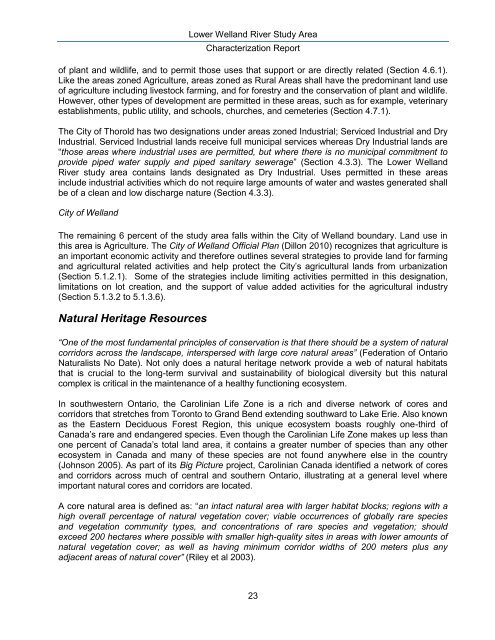Lower Welland River Characterization Report - Niagara Peninsula ...
Lower Welland River Characterization Report - Niagara Peninsula ...
Lower Welland River Characterization Report - Niagara Peninsula ...
You also want an ePaper? Increase the reach of your titles
YUMPU automatically turns print PDFs into web optimized ePapers that Google loves.
<strong>Lower</strong> <strong>Welland</strong> <strong>River</strong> Study Area<br />
<strong>Characterization</strong> <strong>Report</strong><br />
of plant and wildlife, and to permit those uses that support or are directly related (Section 4.6.1).<br />
Like the areas zoned Agriculture, areas zoned as Rural Areas shall have the predominant land use<br />
of agriculture including livestock farming, and for forestry and the conservation of plant and wildlife.<br />
However, other types of development are permitted in these areas, such as for example, veterinary<br />
establishments, public utility, and schools, churches, and cemeteries (Section 4.7.1).<br />
The City of Thorold has two designations under areas zoned Industrial; Serviced Industrial and Dry<br />
Industrial. Serviced Industrial lands receive full municipal services whereas Dry Industrial lands are<br />
“those areas where industrial uses are permitted, but where there is no municipal commitment to<br />
provide piped water supply and piped sanitary sewerage” (Section 4.3.3). The <strong>Lower</strong> <strong>Welland</strong><br />
<strong>River</strong> study area contains lands designated as Dry Industrial. Uses permitted in these areas<br />
include industrial activities which do not require large amounts of water and wastes generated shall<br />
be of a clean and low discharge nature (Section 4.3.3).<br />
City of <strong>Welland</strong><br />
The remaining 6 percent of the study area falls within the City of <strong>Welland</strong> boundary. Land use in<br />
this area is Agriculture. The City of <strong>Welland</strong> Official Plan (Dillon 2010) recognizes that agriculture is<br />
an important economic activity and therefore outlines several strategies to provide land for farming<br />
and agricultural related activities and help protect the City‟s agricultural lands from urbanization<br />
(Section 5.1.2.1). Some of the strategies include limiting activities permitted in this designation,<br />
limitations on lot creation, and the support of value added activities for the agricultural industry<br />
(Section 5.1.3.2 to 5.1.3.6).<br />
Natural Heritage Resources<br />
“One of the most fundamental principles of conservation is that there should be a system of natural<br />
corridors across the landscape, interspersed with large core natural areas” (Federation of Ontario<br />
Naturalists No Date). Not only does a natural heritage network provide a web of natural habitats<br />
that is crucial to the long-term survival and sustainability of biological diversity but this natural<br />
complex is critical in the maintenance of a healthy functioning ecosystem.<br />
In southwestern Ontario, the Carolinian Life Zone is a rich and diverse network of cores and<br />
corridors that stretches from Toronto to Grand Bend extending southward to Lake Erie. Also known<br />
as the Eastern Deciduous Forest Region, this unique ecosystem boasts roughly one-third of<br />
Canada‟s rare and endangered species. Even though the Carolinian Life Zone makes up less than<br />
one percent of Canada‟s total land area, it contains a greater number of species than any other<br />
ecosystem in Canada and many of these species are not found anywhere else in the country<br />
(Johnson 2005). As part of its Big Picture project, Carolinian Canada identified a network of cores<br />
and corridors across much of central and southern Ontario, illustrating at a general level where<br />
important natural cores and corridors are located.<br />
A core natural area is defined as: “an intact natural area with larger habitat blocks; regions with a<br />
high overall percentage of natural vegetation cover; viable occurrences of globally rare species<br />
and vegetation community types, and concentrations of rare species and vegetation; should<br />
exceed 200 hectares where possible with smaller high-quality sites in areas with lower amounts of<br />
natural vegetation cover; as well as having minimum corridor widths of 200 meters plus any<br />
adjacent areas of natural cover” (Riley et al 2003).<br />
23

















